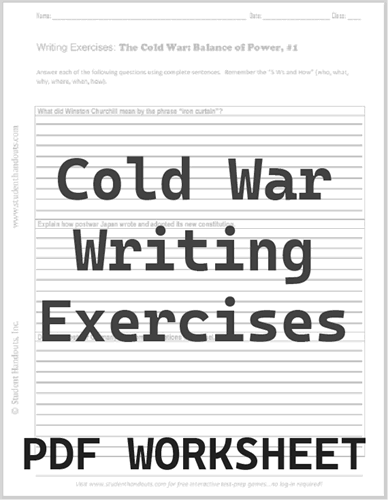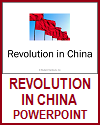| Cold War Writing Exercises Worksheets |
|---|
| www.studenthandouts.com ↣ World History ↣ Cold War ↣ Cold War Printable Worksheets |
 |
    |
|
Cold War Writing Exercises Sheet #1 - Answer each of the following questions using complete sentences.
1. What did Winston Churchill mean by the phrase "iron curtain"? Winston Churchill used the phrase "iron curtain" in 1946 to describe the sharp division between Western Europe and the Soviet-controlled Eastern Europe after World War II. It symbolized the growing ideological and physical separation between democratic nations in the West and communist regimes in the East, marking the start of the Cold War. The "iron curtain" represented a barrier to freedom, information, and political influence. 2. Explain how postwar Japan wrote and adopted its new constitution. Postwar Japan's constitution was drafted under U.S. occupation (1945-1952). Supreme Commander Douglas MacArthur directed American officials to write a democratic charter, emphasizing pacifism (Article 9) and human rights. The Japanese government, led by Prime Minister Shigeru Yoshida, revised the draft, which was then approved by the Diet in 1946. Promulgated in 1947, it replaced the Meiji Constitution, establishing a parliamentary system and renouncing war—a framework unchanged since. 3. Describe postwar Germany’s diplomatic relations with Israel. Postwar Germany established diplomatic relations with Israel in 1965, following reparations agreements (1952 Luxembourg Accords) to compensate Holocaust survivors. West Germany, seeking moral and political rehabilitation, provided economic aid and became a key Israeli ally. Relations strengthened over time, with Germany consistently supporting Israel's security. After reunification (1990), Germany maintained this stance, balancing criticism of Israeli policies with unwavering commitment to Israel's right to exist. Ties remain strong, rooted in historical responsibility. Click here to print. Answers will vary. |
|
Cold War Writing Exercises Sheet #2 - Answer each of the following questions on the postwar era using complete sentences.
1. How was Germany organized following World War II? After World War II, Germany was divided into four occupation zones controlled by the U.S., U.K., France, and the U.S.S.R. (1945). The Cold War split the country: the Western zones became the Federal Republic of Germany (F.R.G., 1949), a democratic state, while the Soviet zone became the communist German Democratic Republic (G.D.R., 1949). Berlin was similarly divided. Reunification occurred in 1990 after the G.D.R. collapsed. 2. What was the impact of the Holocaust on those European Jews who survived World War II? The Holocaust left survivors with profound trauma, loss of family, and shattered communities. Many faced displacement, poverty, and lingering antisemitism in postwar Europe. Some emigrated to Israel, the U.S., or elsewhere, rebuilding lives amid enduring psychological scars. Survivors played key roles in Holocaust remembrance, justice efforts, and Jewish cultural revival, but their experiences underscored the genocide's horrific legacy. 3. Describe postwar Germany’s adoption of one of Europe’s most liberal asylum laws. Postwar West Germany, reflecting on its Nazi past and Cold War humanitarian commitments, enshrined a liberal asylum right in its 1949 constitution (Article 16a), granting protection to those persecuted on political grounds. The law became one of Europe's most generous, though it was tightened in the 1990s after a surge in applications. This legacy underscored Germany's moral reckoning with its history while shaping modern debates on migration. Click here to print. Answers will vary. |
|
Cold War Writing Exercises Sheet #3 - Answer each of the following questions using complete sentences.
1. Describe the two superpowers of the Cold War. The Cold War was dominated by two superpowers: the United States, a capitalist democracy promoting global influence through N.A.T.O., economic aid (Marshall Plan), and military strength, and the Soviet Union, a communist state that expanded its sphere via the Warsaw Pact, satellite states, and ideological influence. Their rivalry fueled proxy wars, arms races (e.g., nuclear buildup), and space competition, defining global politics until the USSR's collapse in 1991. 2. Explain the role of the United Nations in Korea following World War II. Following World War II, the U.N. temporarily oversaw Korea's transition to independence, proposing reunification elections after Japan's surrender. When North Korea invaded the South in 1950, the U.N. Security Council (with the U.S.S.R. absent) authorized a U.S.-led military intervention, marking its first collective security action. The Korean War (1950-53) ended in a stalemate, solidifying division, with the U.N. maintaining a symbolic role in monitoring the armistice and supporting South Korea's legitimacy. 3. What is meant by the term surrogate (or proxy) war? Give at least two examples. A proxy (or surrogate) war occurs when rival powers (e.g., U.S. and U.S.S.R. during the Cold War) support opposing sides in a conflict without direct confrontation. Examples include the Vietnam War (1955-75), in which the U.S. backed South Vietnam against Soviet- and Chinese-supported North Vietnam, and the Soviet-Afghan War (1979-89), in which the U.S. armed Afghan mujahideen against the U.S.S.R.-backed communist government. Proxy wars allow superpowers to compete indirectly. (Teachers may bring up more recent examples, such as the U.S. arming Ukraine against Russia.) Click here to print. Answers will vary. |
|
Cold War Writing Exercises Sheet #4 - Answer each of the following questions using complete sentences.
1. Compare and contrast North Korea and South Korea. North vs. South Korea: North—Communist, authoritarian regime (Kim dynasty), isolated, centralized economy, nuclear-armed. South—Democratic, capitalist, globally integrated, advanced economy, U.S.-allied. Divided since 1948, the Korean War (1950-53) solidified their split. 2. Summarize the events of the Vietnam War. Vietnam War (1955-75): Communist North Vietnam (backed by the U.S.S.R. and China) fought U.S.-supported South Vietnam. After U.S. withdrawal (1973), North unified Vietnam under communism in 1975, marking a Cold War proxy war defeat for America. 3. U.S. President George W. Bush (2001-2009) included North Korea in his "Axis of Evil." Why, half a century after the end of the Korean War, did many Americans view North Korea as a threat? Many Americans viewed North Korea as a threat due to its pursuit of nuclear weapons, aggressive rhetoric, and human rights abuses. Despite the 1953 armistice, the regime remained hostile, conducting missile tests and threatening the U.S. and American allies. North Korea's unpredictable leadership, isolation, and history of provocations (e.g., sinking South Korean ships) reinforced fears of regional instability and potential conflict, justifying its inclusion in the "Axis of Evil." Click here to print. Answers will vary. |
| Cold War Books and Films | Cold War Outlines and PowerPoints |
| Cold War Maps and Pictures | Cold War Learning Games |
| Cold War Miscellany | Cold War Worksheets |
| www.studenthandouts.com ↣ World History ↣ Cold War ↣ Cold War Printable Worksheets |








